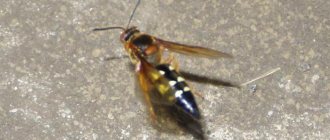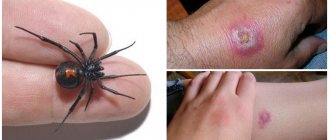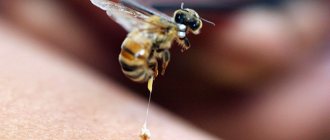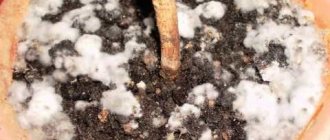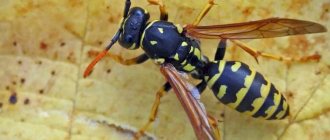Danger of insect bites
Most species of insects living on the planet do not pose a threat to the human body.
However, the bites of some creatures can lead to negative manifestations. The greatest danger to humans is posed by poisonous species and some ants.
Most often, poisonous insects encounter humans while defending themselves. Flying parasites can also cause harm. These are some flies, gadflies, mosquitoes, etc. When the skin is damaged by their stings, a toxin enters the bloodstream, which can cause allergies.
Symptoms of an insect bite
The nature of the manifestations resulting from the bite depends on the type of insect. General signs:
- hematomas, bruises and bumps in the damaged area;
- pain;
- redness;
- burning and itching.
Do not scratch the bitten area, otherwise infection may enter the wound.
Swelling
It often happens that after an insect bite, the leg, arm and other parts of the body become swollen. The severity and localization of swelling depends on the type of pest and the location of the damage. In most cases, swelling from a bite goes away on its own within a few hours. If your leg or any other part is swollen and the swelling does not subside, you should immediately consult a doctor.
Itching and redness
Most often, itching and redness appear after bites of bedbugs, fleas and mosquitoes. To relieve discomfort, you can use pharmacy or folk remedies.
Pain
Painful sensations appear when stung by bees, spiders, scorpions and poisonous creatures. In some situations, pain occurs only a few minutes after the injury.
Hyperemia
This condition is accompanied by redness of the damaged epidermis. Hyperemia accompanies any bites. It can only differ in severity and duration.
Allergy to insect bites
In most situations, parasite bites provoke the development of an allergic reaction. Main symptoms:
- painful sensations;
- swelling;
- red spots near the affected area;
- itching;
- increase in local temperature.
Most often, allergies do not require specific therapeutic measures. But in some situations, allergies are accompanied by more severe symptoms:
- stress;
- increased heart rate;
- problems with respiratory function;
- swelling of the larynx and face;
- dizziness;
- a sharp decrease in blood pressure;
- severe itching;
- skin rashes.
If you have these manifestations, you should definitely go to the hospital.
Particular care should be taken if the tumor begins to grow rapidly after an insect bite.
The use of folk recipes
Folk recipes for mosquito bites
If your leg or arm is swollen after a mosquito bite, you can also use folk remedies, which are accessible and safe.
- A soda solution will reduce swelling and swelling (1 tablespoon of soda for 0.5 cups of water). A cotton pad soaked in this solution is applied to the affected area.
- Soda gruel, which is left at the site of the bite until it dries completely, relieves swelling and the associated inflammatory process.
- The juice of plantain, dandelion or cabbage helps reduce the inflammatory process. Or you can simply apply a washed and well-crushed leaf of any of these plants to the bitten area.
- No less effective for edema is celandine, or rather the juice from it, which has a disinfecting effect. A napkin moistened with it is applied to the lesion several times a day. It is preferable to use the stems of the plant to squeeze out the juice.
- Raw potatoes have similar properties. It is enough to cut the tuber and apply it to the swelling with the cut side.
- Swelling on an arm or leg will quickly go away if you apply garlic and onion mixture to the swollen area.
On a note!
Treatment with one or another agent should be carried out several times a day until the inflammatory process begins to decrease.
However, do not forget that the above recipes are effective only in the initial stages of the development of an allergic reaction. If the swelling in the arm or leg is already quite large, then drug treatment cannot be avoided. You should not hesitate if the tumor is localized on the neck or face, especially when the eye is swollen after a mosquito bite. If applying cold to the affected area does not produce results, you should immediately seek medical help.
How to determine who bitten by footprints
The bites of different types of insects have their own characteristics. They have different external manifestations, signs and consequences.
Bedbugs and linen lice
In most situations, bed bugs leave bites on the human body. These insects are active at night when a person is sleeping. In the first time after damage, practically no signs are visible on the skin. In rare cases, small red spots appear on the dermis. After 24 hours, redness and swelling occur in the affected area. Research results have shown that these creatures may be carriers of Chagas disease.
Body lice (linen lice) bite in much the same way as bedbugs. Such a bite can lead to lice.
Spiders
Most of these representatives of the order Arthropods are non-poisonous. The bites of such creatures are accompanied only by itching and redness. However, in nature there are spiders whose bites provoke severe allergies in the human body. This condition can lead to severe intoxication or skin necrosis.
The most dangerous spider is the black widow spider. The first negative manifestations after contact with this species of arthropod occur within 20-30 minutes. The victim experiences pain and swelling. After 2-3 hours, aches and pains appear in his body, vomiting and nausea develop.
Ticks and fleas
Most often, people become victims of this insect while walking in the forest. Ticks move deftly throughout the human body, so they often leave bites in hard-to-reach places:
- armpits;
- peritoneum;
- groin area;
- skin behind the ears;
- neck.
In this case, the person may not feel any effect on the affected area. Signs of a bite:
- tachycardia;
- headache;
- feeling of weakness.
In addition, ticks are carriers of a large number of diseases. They can cause the development of:
- hemorrhagic fever;
- Lyme disease;
- encephalitis.
There are mites that live under human skin. They are called demodexes and can cause the development of a pathology such as demodicosis.
After flea bites, small reddish dots first appear on the skin, accompanied by moderate itching. Most often, fleas affect the following places:
- peritoneum;
- armpits;
- calf muscles;
- knee area;
- ankles.
An allergy to flea bites is manifested by itching, swelling and redness of the epidermis. Previously, these insects were carriers of plague.
Bees, mosquitoes and midges
Midge and mosquito bites are accompanied by itching and mild swelling. In most cases, discomfort goes away within 1-2 days.
A bee sting is accompanied by severe and immediate pain that can last up to 3-4 hours. The stung area becomes pale in the center, and redness appears around the sting point. In addition, such damage leads to severe swelling. If you are bitten several times, a severe allergy may develop. It is accompanied by the following manifestations:
- feeling of weakness;
- angioedema;
- convulsive conditions;
- dizziness;
- heart rhythm disturbance;
- complete stop of the heart muscle (in case of multiple bites).
Scorpios
As a result of such a bite, the victim immediately experiences pain and burning. Symptoms may vary depending on the type of scorpion. General manifestations:
- swelling;
- pain;
- burning;
- numbness;
- paleness of the skin;
- tachycardia;
- nausea;
- limb spasms;
- redness.
First aid
If the negative symptoms are severe, the victim should immediately call an ambulance. Before the doctors arrive, you need to do the following:
- thoroughly rinse the bite area with running water and laundry soap;
- apply an anti-inflammatory drug to the skin;
- avoid scratching the bite;
- minimize swelling by applying cold to the damaged area;
- treat the bitten area with an antihistamine (Fenistil, etc.);
- Give the victim antihistamines (for example, Suprastin).
Most often, complications can be prevented. However, if you have an allergic reaction, you cannot do without medical help.
If a tick is found under the skin, you should immediately contact a surgeon so that he can remove the parasite in the most effective and safe way. If you cannot see a doctor, you will have to perform the procedure yourself. For this purpose, you need to use small forceps.
The affected area should be treated with a good antiseptic: iodine, chlorhexidine, alcohol or hydrogen peroxide.
The insect removed from the skin must be placed in an airtight glass container. It must be taken to the laboratory for testing within 2-3 days.
If the victim experiences anaphylactic reactions, the following should be done:
- First you need to call an ambulance.
- The victim needs to take a horizontal position and slightly raise his lower limbs.
- After this, you need to apply something cold to the affected area of the skin.
- If the victim loses consciousness, his respiratory function must be carefully monitored. When it stops, emergency resuscitation measures should be carried out (artificial respiration, cardiac massage, etc.).
- If the victim is in a conscious state, he needs to be given antihistamine medications (Tavegil, Suprastin, etc.). Additionally, an injection of Epinephrine should be given in a dosage of 0.1 to 0.3 ml.
- In case of severe pain, you need to take painkillers.
The visiting medical specialists need to tell you as much as possible about what happened. After this, the victim is taken to the hospital and undergoes a thorough diagnosis to identify the cause of the condition and select the optimal method of therapy.
Priority actions
Wash the bite site with running water and soap to prevent infection. The child should be kept from scratching the damaged skin, because this will increase the swelling.
If your child's arm begins to swell after a mosquito bite, you need to cool the damaged skin to slow down the blood flow. Can be applied for 10-15 minutes:
- ice wrapped in a towel;
- a napkin moistened with cold water;
- compress of water and vodka in a 1:1 ratio.
Pressing on the bite with a small hard object (for example, a pencil) helps stop the swelling. Point pressure of moderate force for 10-15 seconds will help.
Treatment of a swollen hand continues with folk remedies and pharmaceuticals.
External remedies for insect bites
For minor redness and swelling, it is enough to apply ice to the problem area. In other situations, you need to use special gels, creams and ointments. Such external remedies after bites have an anti-inflammatory and antihistamine effect. They are used to eliminate negative signs after damage to the epidermis and toxin entering its structure.
For moderate swelling and hyperemia, you can use over-the-counter medications. The antihistamine composition in the form of an ointment is applied directly to the wound. Antipruritic medications should be applied around the problem area.
The most effective drugs:
- Psilo-balm.
- Elidel.
- Calamine.
- Afloderm.
- Bepanten.
- Fenistil.
External products should be used in accordance with the instructions.
Treatment with antihistamines
Antihistamines (anti-allergic) drugs are used when it becomes clear that the immune system cannot cope with allergens that have entered the body on its own. Local medications come to the rescue:
- Advantan. The composition, safe even for children from 6 months, is produced in the form of lotion, cream or ointment. The result after application is visible within 45–60 minutes. In addition to the anti-edematous effect, it relieves inflammation and itching.
- Psilo-Balm. Approved for the treatment of dermatological problems in children from 12 months. The composition contains menthol, which additionally cools the skin.
- Fenistil. A popular composition in the form of a gel, which is prescribed even to children from six months old to reduce the activity of histamine. It is recommended to apply to a swollen leg at least 5 times a day.
- Wundehil.
- Elidel.
- Bepanten.
The effect is reinforced with the following allergy pills:
- Claritin;
- Suprastin;
- Eden;
- Diazolin;
- Elzet.
Treatment with tablets
Not in all cases, medications in the form of ointments and gels show high effectiveness in eliminating the negative consequences of bee, wasp and other insect bites.
To increase their medicinal effect, you can additionally use oral medications (Benadryl, Diphenhydramine, etc.). In addition, in case of severe inflammation, it is necessary to additionally use antimicrobial medications in tablet form. Severe manifestations require injections of the drug Epinephrine.
Folk remedies after insect bites
There are many home recipes that can be used to eliminate the negative consequences resulting from a bite. Their advantages are availability and high efficiency.
Garlic
This product is in any kitchen. With its help you can quickly get rid of swelling and redness. To do this, prepare a garlic-water tincture from 2 crushed heads and 250 ml of clean water. The mixture is applied to gauze or a bandage, which is placed on the bitten area. Garlic tincture is particularly effective in eliminating itching and swelling after bites of midges, horse flies and mosquitoes.
In addition to the tincture, you can use a gruel made from 1 garlic clove. To do this, the mixture must be placed on the skin and covered with a bandage. The gruel helps with bee and wasp stings. In case of suppuration of the wound, the garlic composition can be mixed with honey in the same ratio. However, this technique is not suitable for allergy sufferers and those with sensitive skin, because... Garlic can cause severe burns.
Cabbage
Cabbage leaves help quickly get rid of compaction and swelling in the bite area. To do this, they need to be cut into strips and scalded with boiling water so that their structure softens. Then the strips are applied to the wound and covered with polyethylene, on top of which the fabric is tied. This compress will relieve pain and swelling in just 1 night.
Homemade cabbage ointment is also highly effective. It is prepared from 1/4 of a fresh head of cabbage, a small bunch of parsley and 50-55 g of internal fat (pork). The vegetable should be crushed to a pasty state. You need to squeeze the juice out of the parsley and chop the plant. The components are mixed with pork fat. The finished composition must be stored in the refrigerator. You need to apply it to problem areas 2 times a day. Swelling with its use subsides after 1-2 days. Pain and itching go away faster.
Soda and vinegar
To get rid of severe itching caused by a parasite bite, you can use a thick substance made from water and soda.
To do this, soda powder must be diluted with liquid until a paste-like mixture is obtained. The paste is applied to problem areas and fixed with a plaster and bandage.
As an alternative, you can use a wash with a mixture of 1 tsp. soda and 250 ml of water. This technique is excellent for treating multiple bites.
To eliminate negative symptoms, vinegar 3% is used. A bandage is soaked in it, which is then applied to the location of the tumor and redness. The duration of the procedure is from 20 to 30 minutes. When using this product, you should avoid getting vinegar on the combed areas, as this can cause a chemical burn. In addition, it is prohibited to use the essence of this substance.
Spices
If it is impossible to use vinegar, herbs are used to eliminate swelling. Most often mint and basil are used for this purpose. To prepare basil decoction you need 2 tbsp. l. Boil the dried raw materials in 500 ml of water for 5 minutes. You need to consume half a glass three times a day.
Mint is best used fresh. The juice of the plant is applied to the bites. You can also place the grass in a small fabric bag. The procedure must be performed three times a day for 20-30 minutes.
Hygiene products
In some situations, you can get rid of swelling, redness and itching using personal hygiene products. To do this, use toothpaste and soap. To reduce swelling, you need to thoroughly soap problem areas twice a day. To get rid of itching, apply a little paste with mint to the bite to clean your teeth.
First aid
Wasps are distinguished by their black and yellow color and are highly aggressive. They never leave a stinger in the body because there are no barbs on it.
The same insect can sting more than once. After a bite, hyperemia and swelling immediately develop around the wound, and slight bleeding may occur.
The person feels a strong burning sensation, which subsides after a few hours. Allergy sufferers may have an excessively strong reaction, even leading to anaphylactic shock. True, more often people have allergic reactions to bee stings.
If there is a sting left in the wound, this is a bee sting and the algorithm of actions taken will be practically similar to the measures taken after a wasp sting, which freely removes the stinging apparatus, but there are still minor differences. When there is nothing in the wound, and a bright red dot is visible at the site of penetration, this indicates that the hymenoptera insect belongs to the aspen family.
Most often, a person is stung by the common wasp, which is shown in the photo at the beginning of the article. The wound should be washed with soapy water or clean water, and then treated with an antiseptic.
Suitable for this purpose:
- alcohol, vodka, cognac, whiskey, moonshine or any other type of strong alcohol;
- hydrogen peroxide;
- alcohol tincture of calendula, chamomile (or their decoction);
- iodine.
You can use special antiseptic solutions, for example, Miramistin. If you don’t have any of the above at hand, then it is recommended to use plants that will be mentioned in the article. The inflamed area after the bite will hurt and itch very much.
It is strictly forbidden to comb it, because this will only increase inflammation, and pathogenic microorganisms can penetrate through damaged skin. It is advisable to apply a bactericidal patch to the wound (for several hours) after treatment. Everything written above is suitable for an adult with normal reactions. In other cases, use the tips below.
A red dot at the site of the bite without a sting indicates a wasp sting
After contact with insects, the victim should not move actively, it is better to lie down and drink a lot. If a person begins to get nervous, this aggravates the toxic manifestations of the poison, since steroid hormones begin to be released into the blood, increasing blood circulation, which will lead to an increase in the local allergic reaction.
Therefore, it is important to remain calm. When a person is near the nest, or there are other insects nearby, under no circumstances should you react violently (shouting, waving your arms or moving quickly), because this can cause aggression from other wasps, and in this case there is a risk of being attacked.
Applying cold to the bite site, such as ice or frozen food, has a temporary pain-relieving effect and slows down the absorption of the venom. This will help in the first few hours after the wasp has stung, but after more time it is no longer worth doing. You need to apply ice to the chest or torso very carefully so as not to chill the internal organs or muscle tissue.
Important. If the bite was in the oral cavity, neck, or the insect was swallowed and stung in the throat, the victim should suck on ice. He needs to be given antihistamines, then call an ambulance or urgently take the person to a medical facility. Delay can be fatal, as the person bitten may die from suffocation.
Medicines for bites
Antihistamine
Any person after an encounter with an insect can take an antihistamine to reduce swelling, however, children (6 years of age and older, it is advisable to consult a doctor) and sensitive individuals are strongly recommended to take the following medications:
- suprastin;
- cetrin;
- diphenhydramine;
- tavegil;
- loratadine;
- diazolin;
- desloratodine or edem or other anti-allergy drugs.
When the swelling stops spreading and the strong burning sensation goes away (as a rule, this will take from 3 to 6 hours), the inflammation area can be lubricated with bite cream or an antiallergic external remedy:
- psilo-balm;
- fenistil;
- rescuer;
- panthenol;
- hormonal drugs (only as prescribed by a doctor): lakoid, fluorocort, hydrocartisone ointment, diprosalic or others.
Based on the presence of symptoms of intoxication (dyspepsia, fever, low-grade fever, headaches), we can talk about the poison getting into large blood vessels. In this case, you should drink as much liquid as possible and take adsorbents (smecta, activated carbon and others).
Important. You should not take antihistamines or hormonal drugs for a long time without the approval of your doctor. You should always read the instructions in the package insert and study the contraindications so as not to provoke the development of a side effect.
Help in the field
Most often, people are stung by insects far from the city, where there are no necessary medications, and it takes a long time to get to the nearest hospital or pharmacy. In this case, the tips listed in the table will come in handy.
First aid methods after a stinging insect bite
Table. Folk remedies to reduce swelling after a wasp bite:
| What do we have to do | Description |
| If there is a river or lake nearby, then the bite site should first be washed with clean water, and then your hand or foot should be immersed in the water. |
| Cut an onion, lemon or unripe apple and immediately apply it to the wound, as the acid will neutralize the poisonous proteins. Vinegar will also work for this purpose. |
| You can apply mashed leaves of sorrel, plantain, parsley or squeeze the juice out of them, moisten the wound first, and then apply moistened swabs. To relieve itching, you can use mint, dandelion, wormwood or alcohol tincture of calendula. |
| Drink plenty of fluids and stay calm. It is advisable to drink fresh, weak, sweetened tea, or even better, clean water. |
What is forbidden to do after a bite
After a bite, do not scratch the affected area or expose it to prolonged exposure to direct sunlight. In addition, the damaged area must be protected from contact with chemicals and aggressive influences.
When bitten by ticks, it is forbidden to use improvised devices for extracting the parasite (pins, tweezers, etc.), because the head of the insect can remain in the epidermis and provoke a severe inflammatory process and additional complications.
Experts also do not recommend burning ticks, because such manipulation will force the parasite to go deeper into the epidermal layers. You shouldn’t crush an insect either, because pathogenic microorganisms that may be present in it will enter the bloodstream and provoke the development of an infectious disease.
Bitten areas should not be treated with fatty substances (oil, kerosene, etc.), because they can lead to the fact that the tick does not have time to get out and remains in a dead state in the skin.
In addition, when bitten, the victim should not be left alone, and the sting remaining in the skin should not be squeezed while removing it.


